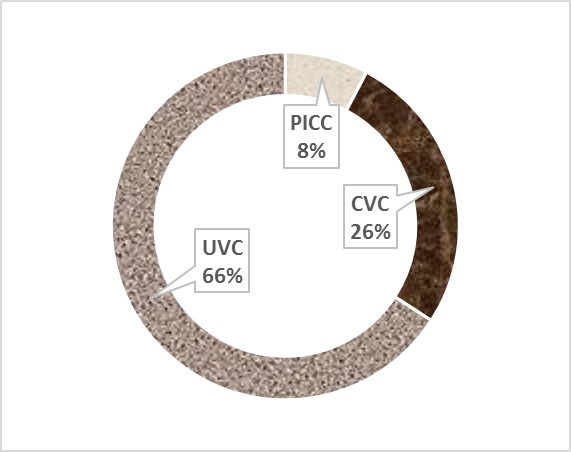Central lines in a tertiary NICU its Indication & outcome – A descriptive study
Abstract
Introduction: Vascular access especially in critically ill and preterm neonates is a major life saving procedure. There is a need for a sustained access for medications and providing the essential nutrition in sick babies. Various techniques and sites are used for IV lines in the intensive care. There are also some known and associated complications with central lines.
Objectives: To describe the indications for insertion, indication for removal, type of central line and outcome of central lines placed in neonates.
Methodology: This is an audit of central lines inserted in a tertiary care neonatal ICU between January 2016 to December 2016.
Results: A total of 284 central lines either as umbilical, central or PICC lines were inserted. 63% of the lines were inserted through the umbilical vein and 21% through the femoral route mostly in surgical neonates. The most common central line inserted was the umbilical catheter (66%). The medical team inserted 73% of the lines while the remaining 27% was by the surgical team. Central lines in our unit were associated with minimal complications with only 3 babies posing with prolonged bleeding from insertion site. The most common indication for insertion was for infusion of multiple medications (62.7%) and inotropes (9.9) %. Majority of the lines were removed when the indication for use ceased (66.2%).
Conclusion: Umbilical line is the most common central line inserted in neonates followed by surgical long lines. Indications for use can be varied and complications are minimal if proper technique and care is followed.
Downloads
References
2. McCay AS , Elliott EC, Walden M. Videos in clinical medicine. PICC placement in the neonate. doi: 10.1056/NEJMvcm1101914.[pubmed]
3. Mactier H, Alroomi LG, Young DG, Raine PAM. Central venous catheterisation in very low birth weight infants. Archives of Disease in Childhood .1986; 61: 449-453.
4. Cartwright DW. Central venous lines in neonates: a study of 2186 catheters. DOI:10.1136/adc.2004.049189.[pubmed]
5. Jadhav V, Shankar G, Deepak J, Babu N. Percutaneous cannulation of central veins in neonates: Its safety and feasibility: Audit of 75 neonatal insertions. Indian J Child Health.2016 Jan-Mar; 3(1):49-53.
6. Soe A. Central venous catheterisation in newborn infants: Results of an audit. Infant. 2007; 3(1):1172-175.
7. Stocker M , Berger TM. [Arterial and central venous catheters in neonates and infants]. DOI:10.1007/s00101-006-1052-1.[pubmed]
8. Rao S , Alladi A, Das K, Cruz AJ. Medium and long term central venous access in children. Indian Pediatr. 2003 Jan;40(1):41-4.[pubmed]
9. Gomes AV , Nascimento MA. [Central venous catheterization in pediatric and neonatal intensive care units]. DOI:10.1590/S0080-623420130000400004.[pubmed]
10. Bhatt S, Dahat A, Jain N, Nayak U, Patel V.Indications and complications of central venous catherization in critically ill children in intensive care unit. NJMR. 2012 Jan-Mar; 2(1); 85-89

Copyright (c) 2018 Author (s). Published by Siddharth Health Research and Social Welfare Society

This work is licensed under a Creative Commons Attribution 4.0 International License.


 OAI - Open Archives Initiative
OAI - Open Archives Initiative


